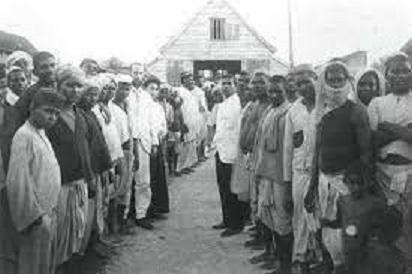Africa-Press – Mauritius. THE 2nd November 2003 marks the 169th anniversary of the arrival of the first indentured Indian immigrants in Mauritius. The 2nd November is a public holiday of national commemoration because it is a day of deep reflection on the great toils and struggles of the indentured labourers and their contribution in the fashioning of Mauritius.
The pioneer indentured labourers Recent research at the Mauritius Archives has provided new information on the indentured labourers who came to Mauritius on the Atlas on Sunday, 2nd November 1834. The story of these pioneer Indian labourers began almost two months earlier in Calcutta, India.
On 10th September 1834, 36 Hill Coolies of the Dhangar caste (originally from the hills of Bihar in eastern India who were then living in Calcutta) signed a five-year labour contract with George Charles Arbuthnot of Hunter-Arbuthnot & Company, a major British trading company in Mauritius, in the presence of C.
McFarlan, at the Calcutta Police Head Office. MacFarlan, the Chief Magistrate of Calcutta, read and explained in detail the contract to the Indian labourers with the help of an Indian interpreter.
Once the labourers agreed to the terms and conditions, they placed their thumb mark on the contract and on a separate list, which contained the names of the 36 Coolies, they placed an ?X? next to their names.
The sirdar of these labourers was called Sooroop who was assisted by Subaram. In all, there were 30 males and 6 females among Arbuthnot?s coolies, some of their names were Callachaund, Dookhun, Bhomarah, Bhoodhoo, Lungon, and Bhudhram.
The labour contract, which these labourers signed, was written in Bengali. Furthermore, the salary for the males was five rupees per month and for the females only four rupees per month.
The sirdar was paid ten rupees per month and the assistant sirdar around eight rupees per month. In fact, they all received six months? pay in advance before boarding the Atlas. It was Hunter Arbuthnot & Company that paid for their journey from Calcutta to Port Louis.
As a result, one rupee was deducted from their monthly wages by that British company for the return passage to India and they were also going to be provided with food, clothing, lodging and medical care.
The Arrival of Arbuthnot?s Coolies On the same day that the labour contract was signed, MacFarlan sent a letter to H. Prinsep, the Secretary to the Government of the Bengal Presidency, informing him of the agreement.
The Chief Magistrate requested the Vice-President and Governing Council of the Bengal Presidency to give their stamp of approval to the contract and to allow the labourers to sail for Mauritius.
On 15th September, the Vice-President in Council gave his assent to the contract. On the very same day, the 36 Hill Coolies embarked on the Atlas and began their historic voyage to British Mauritius.
The Atlas was under command of Captain Hustwick and was also transporting George Arbuthnot and other passengers as well as a large cargo of rice. After a long voyage of more than six weeks, the Atlas sailed into Port Louis harbour on Sunday afternoon, 2nd November 1834.
However, George Arbuthnot had to wait until the following day before starting the formalities in order for his labourers to be landed on Mauritian soil.
On Monday morning, 3rd November, Arbuthnot, wrote an official letter on behalf of Hunter-Arbuthnot & Company to Governor Nicolay, which requested that: ?they be allowed to land 36 Hill Coolies from the ship Atlas, whom they intend to employ on their Estate, under guarantee that they shall not become a charge on the Colony?.
Hunter-Arbuthnot & Company provided Governor Nicolay with a financial guarantee which was kept in trust by the local colonial government in the Colonial Treasury and would be returned to that British company after the five-year contract of the labourers had expired.
As a result, during the afternoon of 3rd November, permission for the landing of the labourers was given by the British governor. However, it was only on Tuesday morning, 4th November, that the 36 Hill Coolies were landed close to the old Customs House, not far from the present-day Aapravasi Ghat.
Later that same day, Arbuthnot?s coolies were taken to Belle Alliance Sugar Estate near present-day Piton, in Rivière du Rempart. In 1834, Belle Alliance was owned by Hunter-Arbuthnot & Company and it stretched over an area of 502 acres and had a workforce of between 190 to 200 slaves.
The Indian labourers worked from sunrise to sunset, six days a week and they were also required to perform light duties on Sundays. Thus, they worked side by side with the slaves of Belle Alliance in the sugarcane fields.
The arrival of Arbuthnot?s coolies is the particular event that is commemorated each year on 2nd November at the Aapravasi Ghat. In 1950, Dr Brenda Howell, a British historian, called these first Indian labourers ?the pioneers of a migration which was eventually to transform the character of Mauritian life and industry.
? Furthermore, during the first period of the indenture system, between November 1834 and May 1839, around 25 468 Indians were introduced into this small Indian Ocean island.
The Demographic Revolution Between the mid-1830s and early 1860s, at the same time that Mauritius was going through a prolonged sugar revolution, it was also going through a demographic revolution.
After all, in 1834, the Indians made up less than 4 % of the colony?s total population and by 1860, they constituted more than 66% of the total population.
This fact is not surprising because in 1949, Rene Kuczynski, a famous British colonial demographer, explained that between 1834 and 1910, around 451 796 Indian labourers (346 036 males, 105 760 females) were brought to Mauritius.
During that same period, around 294 257 labourers remained in the colony, while 157 539 (128 761 males, 28 778 females) returned mostly to India, with some migrating to Natal in South Africa, British Guyana, Trinidad and Fiji.
Resistance of the Indian labourers Between the 1840s and 1860s, the British colonial government of Mauritius passed laws which sanctioned the double cut system (or a system under which a worker lost two days? pay for being absent from work for one day), restricted the freedom of movement of the Indian labourers, enacted a pass law, allowed for corporal punishment, and extended their labour contract.
By the 1860s, an extremely repressive system was set into place which was enforced by the colonial police for the benefit of the sugar planters. The height of this repression lasted between 1860 and 1880. Fortunately, the Indian labourers actively resisted by organizing strikes and filing complaints against their employers or the sugar estate owners.
Between 1860 and 1885, the sugar estate labourers filed 110 940 complaints with the stipendiary magistrates and Protector of Immigrants against their employers or an average of 4437 per annum, with 72% of these complaints concerning non-payment of wages.
Most of the employers were found guilty by the stipendiary magistrates and forced to pay. But, it also became evident that the labourers needed an ally and when they looked for a defender and spokesperson for their valiant cause, they found one in Adolphe de Plevitz, a sugar planter from Nouvelle-Découverte.
Ever since the late 1860s, de Plevitz became concerned about the terrible plight of the Indian labourers. In 1870, he wrote a petition (also called the ?de Plevitz Petition?) on their behalf and it was signed by 9 401 Indian immigrants.
Eventually, this historic petition was sent to Governor Gordon by de Plevitz himself. Between 1872 and 1873, a Royal Commission of Inquiry was appointed by the British imperial government in London and sent to Mauritius.
For many months, it carried out a lengthy investigation into the working and living conditions as well as the grievances of the island?s Indian labourers.
In 1875, in their voluminous report, the Commissioners made several recommendations to alleviate the terrible plight of the colony?s labourers. Gradually, between the late 1870s and early 1920s, the repressive apparatus of the indenture system was being dismantled.
However, during that same period, there were few improvements in the economic, social, and political conditions of the indentured labourers and their descendants in Mauritius.
In 1922, a new Labour Law was enacted by the Council of Government which hardly brought any changes to the working and living conditions of Mauritian workers on the sugar estates.
Maharaj Kunwar Singh?s Report From 1906 to 1910, only 1 736 labourers arrived in Mauritius from the Indian subcontinent. Furthermore, between 1923 and 1924, around 1395 labourers landed at the Aapravasi Ghat and in May 1924, the last batch of Indian immigrants set foot on Mauritian soil.
By December 1924, more than half of these labourers were not satisfied with their working conditions and opted to return to India. In January 1925, Kunwar Maharaj Singh, a high-ranking officer of the United Province Civil Service in India and a member of an aristocratic dynasty of Oudh, was despatched by the British Government of India to Mauritius.
Hugh Tinker, a British historian, eloquently observes: ?At last, an Indian official of standing had been deputed to examine the situation of overseas Indians.
? Maharaj Singh?s objective was to investigate the economic and social conditions of the Indians in Mauritius and whether the colony really needed to import additional Indian labourers.
On 27th February 1925, Maharaj Singh submitted his report to the British Government of India. He mentioned that Indian labourers had achieved a great deal economic integration in the colony and strongly recommended that Indian indenture should be terminated.
Singh concluded:?Indentured labour made the immigrant forget his home and his people. He came to Mauritius to settle for life and often reindentured. He passed a life of great difficulty and he worked hard?and the system of morcellement helped him to acquire land in proprietary tenure?. In general Indians have bettered their conditions in Mauritius?.
The Indo-Mauritian agriculturalist is better clothed than his confrere in India and, though the houses are poor, the furniture in them showed a higher standard of living?The further dispatch of unskilled labour from India to Mauritius is unnecessary and undesirable either in the immediate or in the near future.
? Within a few weeks after Maharaj Kunwar Singh submitted his report, the British Government of India accepted his recommendation and no more Indian indentured labourers were sent to Mauritius.
The indenture system abolished While active Indian immigration came to an end in 1924, it certainly did not mean that the indenture system was abolished and this process officially took place only between 1938 and 1939.
In November 1938, the local British government replaced the Labour Law of 1922 with the Labour Ordinance of November 1938. This new labour law brought the protection, regulations for payment of wages as well as working hours and all matters concerning the Mauritian workers under the control of the Labour Department.
It became law in January 1939 and during November of the same year, through Ordinance No.47, the title of the Office of the Protector of Immigrants and Poor Law Commissioner was changed to that of Director of Labour.
In effect, the Protector of Immigrants was officially replaced by the Director of Labour. Without doubt, these actions brought an end to a system which had existed for a century in British Mauritius.
In conclusion, it is through their labour and sacrifices that the indentured labourers of Mauritius were able to play a major role in the lengthy process of transforming a little known and rugged island into a prosperous country which serves as a shining beacon to the rest of the world.
Therefore, each year, on 2nd November, their achievements and legacy must be honoured by the Government of Mauritius and the Mauritian people.
For More News And Analysis About Mauritius Follow Africa-Press







